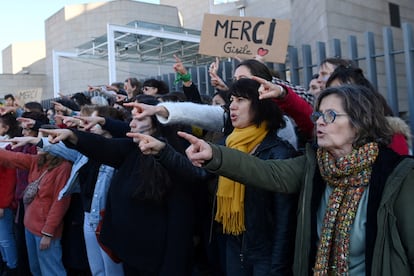11 keys to the Gisèle Pelicot case
Dominique Pelicot has been sentenced to 20 years in prison, the maximum penalty, for raping, drugging and videotaping his wife; the other 50 defendants have also been found guilty

Monday was the last session of what is perhaps one of the most high-profile, shocking, and globalized trials of the last decade. For two reasons. First, the case itself. For a decade, between 2011 and 2020, Dominique Pélicot contacted dozens of men through the internet to invite them to his house, and also to invite them to rape his wife, Gisèle Pélicot, after he drugged her with tranquilizers. There was no money or any kind of exchange; he only asked to be able to record the assaults. At least 72 men passed through that house in Mazan, a town in south-west France. The second issue was the unusualness of the process, which Gisèle Pélicot wanted open to the public so that, as she said during the first sessions of the trial, shame would change sides.
In contrast to the pact of silence maintained by dozens of men for years, protected by the certainty that none of them would speak, what stood out was the conviction of a woman who, when she found out what had happened, decided that she was not the one who had to hide, that she did not want any more silence. Here are some key points of the case.
The trial. It lasted 15 weeks, starting on Monday, September 2 in Avignon and concluding on Monday, December 16. On that day, only 16 of the defendants apologized to Gisèle Pélicot; some have still not admitted what they did even though it was recorded; Dominique Pélicot, who did not deny anything throughout the trial, began his final statement by “praising the courage” of his wife.
The accused. Dominique Pélicot, 71, is the main defendant. He has admitted all the charges against him and has been handed a 20-year prison sentence, the maximum term for rape in France. There are 50 other defendants; for 49 of them, the prosecution is requesting between 10 and 18 years in prison for sexual assault and aggravated rape; for another, it has requested four years in prison for “groping.” And there are, in addition, at least 21 other men who the authorities have not been able to identify.
Personality types. There are none in particular, and this is one of the issues that has been most clearly reflected in this case. Against the established idea in the social imagination about the kinds of individuals who commit these kinds of assaults, there is a reality that clashes head on: the defendants were men of all ages, all backgrounds and all professions. The accused were between 27 and 74 years old, most of them from towns no more than an hour from Mazan — the place where the Pélicots lived and where the rapes took place — and among them there was, for example, a retired sports coach of 69, an unemployed man of 40, a plumber of 54, a bricklayer of 43 and an ex-soldier of 27. Many were good sons, good fathers, good friends, good brothers, good grandparents.
The disciple. Jean-Pierre Maréchal, 63, was a driver for an agricultural cooperative. The French press calls him “the disciple” of Dominique Pélicot because he did not attack the wife of the main defendant, but “learned” through him to attack his own wife, Cilia M, aged 53. They had been married for 30 years and have three children. He and Pélicot photographed her, drugged her with the same tranquilizers that Pélicot used for the other assaults, and raped her at least 12 times.
The monster. It is common to refer to men who commit sexual violence as monsters, but they are, for the most part, men who are perfectly integrated into society. The term monster, experts, theorists and specialists from all fields insistently explain, blurs precisely one of the bases of this violence: its structural nature, its non-exceptionality, its extent. Gisèle Pélicot, testifying before the police, spoke of her husband as “a great guy.” And Cilia M., Jean-Pierre Maréchal’s wife, told the court that “he was a wonderful man,” “a very protective father” with whom “everything always went very well.”
Coco. This is the name of the online platform where Pélicot found the other attackers. It was active between 2003 and last June, when the French police managed to close it down. Like this one, many other online spaces serve every day as a platform, meeting place, and point of contact for attackers, among themselves and with their victims. Sexual crimes committed on the internet or through it are increasing worldwide, especially against minors.
The pact of silence. Sexual violence, like many other forms of gender violence, has historically been maintained through silence. That of the victims, out of fear or shame; that of the perpetrators, obviously; and also that of those who at some point know that this violence has been exercised. In this case, silence was even more essential to maintaining this ongoing crime: for a decade, dozens of men were assaulting an unconscious woman, they knew that others were doing it, they allowed themselves to be recorded, and everyone knew that none of them would inform on the others.
Chemical submission. This is one of the most underestimated forms of sexual violence, but it is increasingly known, studied, analyzed, and included in statistics. Chemical submission is usually opportunistic, meaning that someone takes advantage of another person’s voluntary consumption of alcohol or drugs to exercise violence. The other, proactive form, which occurred in the Pélicot case, which consists of drugging someone without their knowledge in order to attack them, is the least common, according to the available data, although as in this case it sometimes occurs. The problem with the latter is that it is sometimes difficult to identify. Gisèle Pélicot went to the doctor for years with headaches, memory loss, and other symptoms and never thought that behind all this there was a network organized by her husband to abuse her.
The heroine. Gisèle Pélicot has become not only an icon but the image of a society that is advancing faster than ever in recent years in the face of sexual violence and other forms of gender-based violence. Her decision not to hide, because she doesn’t have to, to open the doors of the trial so that the world could know what had happened and who had perpetrated the violence, has made her the recipient of adjectives and nouns such as “heroine” or “brave.” She is. But there is another side to this polyhedron that makes up everything that exists around this violence, and it is why it is so: if society, and the system, were prepared to tackle and deal with this violence, and functioned without cracks to protect the victims, not judge them, believe them, and not hold them responsible to a greater or lesser degree for aggressions against them, women would not have to fight twice as hard: against the violence they have been subjected to and against this system and society. In this case, it was almost impossible for anything to have happened differently because there was evidence, a vast amount of it, to prove it. But what would have happened if there had not been a single recording, a single photo, a single trace on the internet?
It is never just one victim. When a rape occurs, the direct victim is the one who suffers it, but the violence always shoots out in multiple directions, and so do the consequences. The assaults affect entire families in one way or another. The daughter and two sons of Dominique and Gisèle Pélicot, and their grandchildren, are the example in this case. Caroline Darian, whose nude photos were also found among her father’s material, said she felt like a “forgotten victim” of the trial because there is nothing to indicate whether or not there was direct physical violence against her. Florian, 38, the youngest, told his father in one of the sessions that if he had any dignity, he should tell his sister the truth. The eldest, David, 50, said in court that his childhood “had been erased.” Of all the places where violence occurs, the family is the most unknown, most hidden, and most protected space.
The phrase. “Shame must change sides” has become one of the slogans against sexual violence, but it is more than 40 years old. It was first uttered by Gisèle Halimi, the lawyer who led the Tonglet-Castellano case, also known as the Aix-en-Provence trial — the city where the case was heard on May 2 and 3, 1978 — which marked a social, political, and legislative rupture regarding rape. Anne Tonglet and Araceli Castellano, a Belgian couple, were raped by three men on the night of 21 August 1974 in a cove near Marseille. And, as Gisèle Pélicot has now done, both of them, pushed by their lawyer Halimi, wanted the trial to be open to the public so that society, in the case of sexual violence, would look in the right direction: at the aggressors.
Sign up for our weekly newsletter to get more English-language news coverage from EL PAÍS USA Edition
Tu suscripción se está usando en otro dispositivo
¿Quieres añadir otro usuario a tu suscripción?
Si continúas leyendo en este dispositivo, no se podrá leer en el otro.
FlechaTu suscripción se está usando en otro dispositivo y solo puedes acceder a EL PAÍS desde un dispositivo a la vez.
Si quieres compartir tu cuenta, cambia tu suscripción a la modalidad Premium, así podrás añadir otro usuario. Cada uno accederá con su propia cuenta de email, lo que os permitirá personalizar vuestra experiencia en EL PAÍS.
¿Tienes una suscripción de empresa? Accede aquí para contratar más cuentas.
En el caso de no saber quién está usando tu cuenta, te recomendamos cambiar tu contraseña aquí.
Si decides continuar compartiendo tu cuenta, este mensaje se mostrará en tu dispositivo y en el de la otra persona que está usando tu cuenta de forma indefinida, afectando a tu experiencia de lectura. Puedes consultar aquí los términos y condiciones de la suscripción digital.
More information
Archived In
Últimas noticias
Most viewed
- Pablo Escobar’s hippos: A serious environmental problem, 40 years on
- Reinhard Genzel, Nobel laureate in physics: ‘One-minute videos will never give you the truth’
- Why we lost the habit of sleeping in two segments and how that changed our sense of time
- Charles Dubouloz, mountaineering star, retires at 36 with a farewell tour inspired by Walter Bonatti
- The Florida Keys tourist paradise is besieged by immigration agents: ‘We’ve never seen anything like this’










































